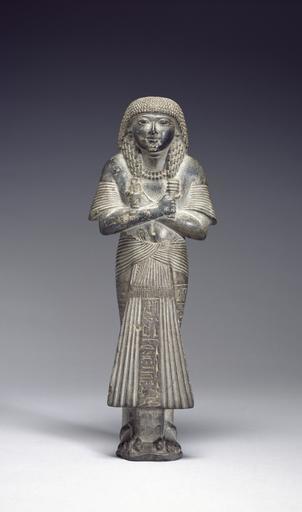MAKE A MEME
View Large Image

| View Original: | Egyptian_-_Ushabti_Figure_of_Amen-em-ipet_-_Walters_22177.jpg (1062x1798) | |||
| Download: | Original | Medium | Small | Thumb |
| Courtesy of: | commons.wikimedia.org | More Like This | ||
| Keywords: Egyptian - Ushabti Figure of Amen-em-ipet - Walters 22177.jpg This dark gray stone ushabti belonged to Amen-em-ipet the Chief of the Doorkeepers Typical of ushabtis of the Ramesside Period he does not wear a mummiform garment but rather a long pleated robe representative of the clothing of the upper class On the pleated apron at the front of the robe The dividing lines between the lines of text have been painted red The figure stands upon a small rounded base and seems to have a squared pillar between his feet Also typical of this period he wears a duplex wig with the hair curled into small plaits and a double necklace His arms are crossed over his chest and he holds a djed pillar the symbol of stability in his right hand and a tjet or knot of Isis in his left hand for protection His face is broad and reminiscent of a funerary mask with delicate cosmetic lines The mouth is well defined and almost smiling and he wears a very short squared beard There is a modern hole beneath the feet from a previous mounting ca 1260 BC New Kingdom dark gray serpentine cm 30 5 11 2 6 5 accession number 22 177 15837 Dikran Kelekian New York and Paris Henry Walters city Baltimore Walters Art Museum Henry Walters Acquired by Henry Walters 1923 Translation Vertical text The Enlightened One Osiris The Chief of the Doorkeepers he says; Translation Horizontal lines of text O' Shabti of the Chief Doorkeeper Osiris Amen-em-ipet true of voice for the doing of any work that is to be done in the Necropolis to cultivate the fields to irrigate the riverbanks to ferry sand from the east to the west or any task that is unpleasant imposed upon him there as a man at his duties The Doorkeeper at anytime Osiris Chief of the Doorkeepers Amen-em-ipet true of voice I will do any work for the Chief of the Doorkeepers Amen-em-ipet true of voice place of origin Egypt Walters Art Museum license Ushabti in the Walters Art Museum Ushabti of the Egyptian New Kingdom | ||||